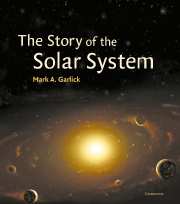Part 3 - Solar System Past and Present
Published online by Cambridge University Press: 10 November 2009
Summary
It is now more than four and a half billion years since the Solar System came into being. Generally there has been little evolution in the grand scheme of things. Along with some of the planets' moons, the asteroids have surfaces that have not been modified extensively since the heavy bombardment stopped, 3300 million years ago. They still populate the belt between Mars and Jupiter. The comets still surround the Sun in the Oort cloud, and the planets' orbits are essentially unchanged.
But on local scales it is a very different story. Since the initial fires of their births so long ago, the planets, their moons and even the Sun have seen significant changes. We will look at these in this, the third part of the book. Starting with the Sun and working our way outwards, we will investigate each of the elements of the Solar System in turn to see what they are like now – and how they have come to be that way. We shall see that the Sun is slightly larger and a bit more luminous today than it was when it was born. It will become evident why the Earth became the only place capable of supporting life, and why it no longer shows signs of its formation. We will discover a different Mars, a waterworld like Earth, and learn how it evolved into the cold and barren desert it is today. And there are other sights too: a larger Mercury than exists today; volcanoes that have changed planets' surfaces beyond recognition; and moons that have been shattered in cosmic impacts and later reformed into new and unusual forms. Having seen where the Solar System came from, it is time now to see how it has evolved.
- Type
- Chapter
- Information
- The Story of the Solar System , pp. 44 - 45Publisher: Cambridge University PressPrint publication year: 2002



